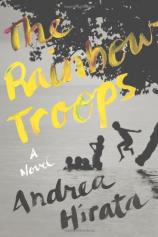Reading Group Guide
Discussion Questions
The Rainbow Troops

1. How does Muhammadiyah Elementary compare to your childhood school? What can we learn from Bu Mus and Pak Harfan about delivering a transformative education?
2. Although the book was inspired by Andrea Hirata’s teachers and childhood friends, The Rainbow Troops is a novel. What can fiction teach us about humanity that a memoir cannot?
3. Just fifteen years old, Bu Mus declined a marriage proposal from a business owner and a job offer in a warehouse. She was determined to fulfill her dream of teaching. What accounts for her devotion to Ikal and his classmates?
4. Bu Mus continually cites Indonesia’s constitutional promise of education for all, but Superintendent Samadikun and the tin mine operators continually try to keep impoverished children out of school. How do these powerbrokers justify their actions? What does the novel illustrate about economics and education? Is it possible to create an education system that leaves no child behind?
5. How are the children affected by the presence of Harun, who saves the day in the first chapter? What does his story say about the benefits and limitations of mainstreaming special-needs children?
6. In chapter six, Ikal says, “One of the extraordinary qualities of Malays is that no matter how bad their circumstances, they always consider themselves fortunate. That is the use of religion.” How do Bu Mus and Pak Harfan use Islam to help their students develop a moral compass and cope with the economic inequalities of their island?
7. The leaky classroom is decorated with a Rain of Money poster featuring the singer Rhoma Irama. Yet in chapter thirty-five, the class politician Kucai and bodybuilder Samson are described as “poisoned by money” because they quit school to become laborers. What does Bu Mus try to teach the students about the value of money versus the value of an education? Growing up on Belitong—one of the richest islands in Indonesia—why must Ikal and his classmates choose between a living wage and an education? Why can’t they have both?
8. What should a society do to nurture its gifted students, such as Lintang? How would he have fared in the United States?
9. Like most children, Flo, Mahar, and other members of the Limpai Group immerse themselves in an imaginary, supernatural world. What special significance does the legend of the Limpai, drawn from their culture’s mythology, have for them?
10. Sahara and Flo are the only female students. How do girls and young woman (including Bu Mus) fare in Ikal’s community?
11. Why does Flo reject her affluent father’s world?
12. In chapter thirteen, the title of the book is explained when Ikal recalls climbing trees with his friends in search of rainbows. What gives them the impulse to seek magical panoramas? How does the incredible beauty of the island shape their hearts and minds?
13. How is Ikal transformed by his love for A Ling? For him, what is the significance of her extraordinarily beautiful fingernails?
14. What aspects of Indonesian culture and history were most surprising to you as you read The Rainbow Troops? As the world’s largest Muslim-majority country, how does Indonesia defy stereotypes?
15. How are parents portrayed in the novel? What is their role in guiding the next generation? How do their children feel about authority?
16. How did you react to the novel’s final portion, set twelve years later, in which Ikal supports his niece Eryn’s education, while power is ironically shifted to the poor on Belitong? What do these pages say about the relationships between government, business, citizens, and family?
The Rainbow Troops
- Publication Date: February 5, 2013
- Genres: Literary Fiction
- Hardcover: 304 pages
- Publisher: Sarah Crichton Books
- ISBN-10: 0374246319
- ISBN-13: 9780374246310






